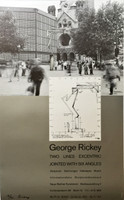
An Educated Collector is Our Best Client
In business for nearly two decades, we are a well established, popular contemporary art boutique specializing in expertly chosen, blue chip prints, multiples, uniques, books, ephemera and merchandise at different price points, with a focus on the secondary market. Please click on the "Contact Us" button at the bottom of this page for questions about any work, pricing and/or to arrange to visit our showroom/gallery - located in between Manhattan's Flatiron and Chelsea Flower Districts.
George Rickey, Two Lines Excentric Jointed with Six Angles, 1986
CONTACT GALLERY FOR PRICE
Description
George Rickey
Two Lines Excentric Jointed with Six Angles, 1986
Limited Edition Offset Lithograph (Hand Signed and Numbered).
Boldly signed and numbered by George Rickey on the front in black marker from the limited edition of only 30. Edition 18/30
39 × 24 1/2 inches
Unframed
Uniquely hand signed vintage offset lithograph poster of renowned kinetic artist George Rickey, hand signed and numbered from the edition of only 30.
Unframed
Provenance
Neuer Berliner Kunstverein
About George Rickey:
"The artist finds waiting for him, as subject, not the trees, not the flowers, not the landscape, but the waving of branches and the trembling of stems, the piling up or scudding of clouds, the rising and setting and waxing and waning of heavenly bodies."
—George Rickey
Born in 1907 in South Bend, IN, George Rickey spent over five decades committed to the creation of poetic and precisely-calibrated sculptures that he referred to as his “useless machines.” Designed to be situated in the public sphere, the works are activated by their interplay with the surrounding environment, reshaping the landscape and bringing heightened attention to aspects of light, movement, and composition. Of all the natural forces, it was the wind’s movement that most captured Rickey’s imagination. He once wrote, “The artist finds waiting for him, as subject, not the trees, not the flowers, not the landscape, but the waving of branches and the trembling of stems, the piling up or scudding of clouds, the rising and setting and waxing and waning of heavenly bodies.”
After initially studying painting in Paris, Rickey returned to the US in 1930 and his career as a painter and muralist developed in the 30s and early 40s, completing works through the WPA and other public commissions. It was during his Army Air-corps War service that he rediscovered his long dormant natural aptitude for mechanics. Already in the mid ’30s he had seen Calder’s exhibition of mobiles in New York, however it was during the War that his thinking about a new and different kind of art began to shift. While familiarizing himself with gyroscopes on B-29 gunnery sights, other important memories were engaged from his youth that would have bearing on his artistic life’s work as a kinetic sculptor—such as the knife edge gimbal that kept the compass and stove level on his family’s yacht growing up in Scotland; and the simple mechanics of a pendulum seen in his grandfather’s clock-making shop as a young boy. In his war years, during free time in the workshop, he started experiments at first with Calder-esque mobiles and then little “machines;” later, other sculptures would be inspired by the movement of flowers, sedges, the clouds and stars in the wind.
Soon afterward, Rickey began to devote himself to the investigation of motion in sculpture, producing dynamic works using simple geometric forms such as lines, squares, rectangles, circles, etc., in which his prodigious understanding of engineering and mechanics is demonstrable. Though the works enthusiastically collaborate with the interference of wind currents in their environment, the speed of their random movements are tempered by simple spacing and fixed arrangement of the elements. The relationship of the parts remains the same, but the dance is always changing. It is this tension that defines Rickey’s sculptures. “I think it’s important to make art that you have to wait for,” said the artist. As such, the works are able to oscillate gracefully through an infinite number of compositional iterations, engaging all aspects of the natural world around them—wind, light, rain, fog, or the lack thereof.
Much of Rickey’s work was created in his studio in East Chatham, New York, where he settled in 1960. Prior to that time, the artist had lived and taught in Bloomington, IN; New Orleans, LA; New York, NY, and throughout the Midwest. His childhood, youth and college years were spent in Scotland and Britain. Aside from East Chatham he had studios in Berlin, Germany and Santa Barbara, CA.
His work is included in the permanent collections of over 150 museums worldwide, including the Hirshhorn Museum and Sculpture Garden, Smithsonian Institution, Washington, D.C.; Los Angeles County Museum of Art, California; Museum of Modern Art, New York; Metropolitan Museum of Art, New York; National Gallery of Art, Washington, D.C.; Walker Art Center, Minneapolis; National Gallery of Scotland, Edinburgh; Museum Boijmans Van Beuningen, Rotterdam and Kunstmuseum Bern, Switzerland, among many others. Key exhibitions include George Rickey: Monumental Sculptures on Park Avenue, New York (2021); A Life in Art: Works by George Rickey, Indianapolis Art Center, Indiana (2009); George Rickey: Kinetic Sculpture, A Retrospective, Vero Beach Museum of Art, Florida; Frederik Meijer Gardens and Sculpture Park, Grand Rapids and McNay Art Museum, San Antonio (2007-09); George Rickey: Kinetische Skulpturen, Museum für Kunst und Gewerbe, Hamburg, Germany (2003) and George Rickey – Retrospective Exhibition, Solomon R. Guggenheim Museum, New York (1979).
Courtesy of Kasmin Gallery








